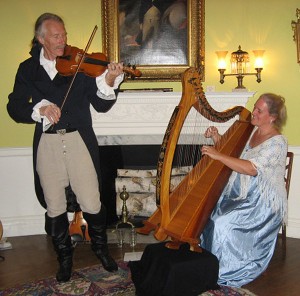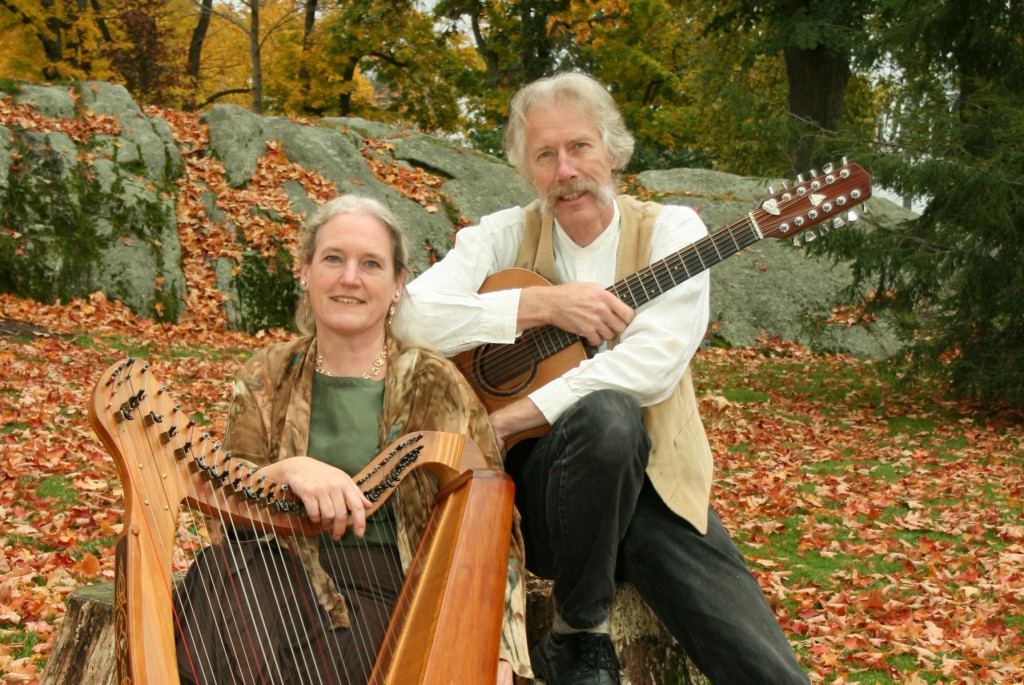
Castlebay: Fred Gosbee and Julia Lane in Library Park, Bath, Maine.
Credit: Martin Kummer. (Photo permission and courtesy of Castlebay.)
Fred Gosbee grew up, fittingly, in Harmony, Maine. He was immersed from the day he was conceived in the traditional music of his family, whose elder members played and sang Irish and Scottish songs.
I had the opportunity to speak with him earlier in the week by phone. He and his wife Julia Lane were driving to Miami to take a brief vacation by going on a cruise to Nassau, the capital city of the Commonwealth of the Bahamas.
I met him, and was fortunate to do so, in my sophomore year when he started attending the University of Maine at Orono [UMO] in 1968. It was about that time that he was studying and playing the classical guitar. I couldn’t remember what he had studied there.
“I was majoring in indecision. I was an art major taking civil engineering courses,” he explained to me.
We became fairly good friends after we first met one another. Soon enough, we discovered we both had a similar interest in music. We explored a wide variety of UMO buildings to discover which buildings had the best acoustics. We learned the upper stairwells at Memorial Union to be the best place to practice guitar and a cappella singing. Fred also had an incredible vocal range, moving easily from a deep rich bass to a soaring tenor voice.
We spent many hours getting the sound of our voices and guitars reverberating back and forth in the stairwell and playing off the sound of the echoes.
Even though Fred’s college advisor was the inimitable Dr. Sandy Ives, Fred dropped out of college in 1970. I recall that along with Vandall King, Bill Haight and a couple of other individuals, he bought a two family building on Stillwater Avenue that was next to the Governor’s Restaurant & Bakery.
The day they signed the papers to the building, the pipes were frozen. Not being taken aback too much from this setback, they did a major rehaul to the structure and turned it back into a single family home. I remember often visiting him there. He spent many late nights and early morning hours in replacing floors, walls and ceilings, as well as replacing the pipes and modernizing the electrical wiring in the house. I was just amazed at his knowledge in what to do and how to go about doing it all.
It was also done with great precision and finesse, two traits of solid workmanship that he has demonstrated throughout his life to date.
Fred ended up being solely responsible for the house. After selling it, he moved to Skowhegan, Maine. He joined forces with Gary Swett of Farmington in learning how to build guitars.
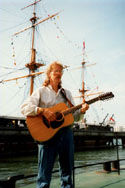
Fred Gosbee with his 12-string guitar in front of HMS “Warrior”, the first iron hulled ship, Portsmouth Naval Shipyard, Portsmouth, England. Credit: Julia Lane (1999). Photo permission and courtesy of Castlebay.
“Gary didn’t now any more about building guitars than I did at the time. We were working from Irving Sloane’s book Classic Guitar Construction published in the 1960s. It was the first good guide to building guitars to be published.”
As his prowess in building guitars deepened, he decided that he wanted to expand his skills.
“I was into Elizabethan music in college. I mentioned this to Sandy. As he had a lute, he let me look at it. It was built by a cabinet maker, but it was unplayable.”
He started building his first lute, finishing it after moving to Jefferson, Maine next.
At odds with what to do next and to make a living, he went to work at Bath Iron Works [BIW] as a shipfitter. It was tough, physically demanding work, but it fascinated him.
“It was like having a giant, 3–dimensional erector set,” he said.
After spending time at BIW, he did a stint working at a salvage outfit in Cundy’s Harbor, which is on the coast about 12 miles due east of Falmouth, Maine. This work did not strike his fancy much and he returned to BIW. He did not do any music during this time in his life.
He did his job so well, BIW appointed him as a supervisor. Again he performed flawlessly. Seeing this depth of potential and talent in Fred, management promoted him to the position of technical writer, then another advancement to industrial engineer was made.
Despite having an office with a window, and a secretary to help him, he grew discontented.
“As a supervisor, I couldn’t touch the tools. So I got a shopsmith as a sanity device. I started making guitars and got reintroduced to music.”
The Chocolate Church in Bath, which is a performing arts center was “instrumental” in helping him get back in touch with music. The late Priscilla Montgomery annually directed Gilbert and Sullivan operettas, as well as the Brunswick Choral Society. She also taught theater arts at Morse High School and was the director for MOHIBA, an annual talent show held at the school. Fred got involved with the operettas and Priscilla immediately recognized his talent not only for singing a wide variety of bass and tenor parts but in composing, too.
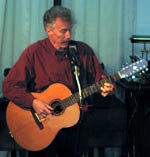
Photo permission & courtesy of Castlebay.
She knew that he had a reasonable repertoire of folk songs. Thus, when she became the music director for the upcoming play, Spoon River Anthology, written in 1915 by Edgar Lee Masters (1868–1950), she asked Fred to put together some music for her.
Please know that I once heard him play 12 hours of them without once repeating a song. I think he could have continued for another two hours, but I was too tired to hear any more, and he needed a break from singing and playing them on his guitar.
Fred put together 53 compositions, including folk songs and tunes, as well as original music, to go along with the characters in the play. The play uses about 75 of the 250 characters in Masters’ Anthology, of which eight to twelve actors usually play multiple roles.
“I found a junk fiddle and mastered it enough to play it for a minor part,” he recalled to me.
Brian Chadbourne was involved in the play. In 1980, he and Fred got together as the duo, “Two of Us”, and they did acoustic versions of popular music, such as Billy Joel’s “Piano Man (1973), in nearby restaurants and bars. Looking around to record their music, they turned to Mark McNeil for help. Mark was a bass guitarist as well and joined them. The duo became a trio for about a year.
One year they were hired to perform at the BIW’s annual picnic at Thomas Point Beach.
“For a joke, we did some country tunes: people went wild over them.”
Soon afterwards, Mark left the trio.
It was during this time that Fred met Julia Lane. He learned that she wanted to make a demo of her music. Fred and Brian sent her to see Mark, who had just obtained a synthesizer.
“It had the horns, strings, percussion—the full works,” Fred told me. “After Julia reigned Mark in and got him to control his enthusiam for the synthesizer, they formed the duo ‘BARRA’”.
During 1987 to 1988, Fred and Brian would join forces on occasion with them as the group “Castlebay”. A live recording was made of their performance at the Olin Art Center at Bates College, which was released as a cassette tape and LP in November of 1987. Somehow the WGBH, nonpareil host of Boston’s Morning pro musica, Robert John Lurtsema (1931–2000), got a hold of a copy of this performance.
Lurtsema, known to his adoring fans as “Robert J”, or “Lurtz”, opened the recording while on air. He played one track and sonorously commented that the music wasn’t bad and interesting enough to have him play another one, which he proceeded to do. This exposure helped launch Castlebay to a far wider audience. They began performing at festivals and concerts throughout New England, venturing to upstate New York and Washington, DC.
Brian left the quartet in 1989, but before leaving, Castlebay recorded four albums. Touring as a trio, they produced three additional albums. In 1993, Mark stopped playing in the group, yet helped in the recording of their 1996 CD, Run Before the Wind.
Fred tried to master playing the folk harp. He decided to obtain a 29–string kit because he wanted to play a bigger harp. Once it was built, he and Julia visited Gordon Bok to show him the harp Fred had made.
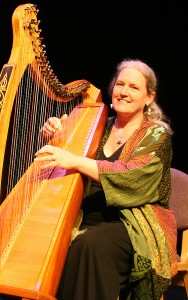
Julia Lane playing spare harp in Flagler College Auditorium (2006), St. Augustine. Florida.
While playing for Gordon, Fred explained, “Gordon wanted Julia to play the harp.
“‘I don’t play the harp’, she told him.
“‘Yes, you do’, Gordon said.’
She went home and mastered it. She has an uncanny memory,” Fred told me.
“She’s nuclear fuel in the engine and I’m the support system.”
Over the years, the two of them have developed a unique body of music, especially in the way the harp and guitar accompany one another in their songs and original music.
In their travels throughout Maine, they found a fellow in Hampden, Maine who was selling off all of his musical instruments.
“He wanted to study the five–string banjo,” Fred said.
One of the instruments was a 35–string harp made in Detroit. They purchased on sight and incorporated into their playing. Fred embarked on making a spare harp after the harp they purchased in Hampden started wearing out. He built one for Julia that had a big sound board, and set specially designed inlay on its pillar. This harp is about 15 years old.
Since then he has made a dozen five octave harps and some other instruments, including a baroque guitar, a baroque harp modeled after the Castle Otway harp and some drums.
Every summer for eleven years, Fred and Julia hosted a Wednesday night concert series in Round Pond, Maine. They still go there and play. It’s only a mile away from their home. They became very popular, and a devoted following of people from Maryland to Florida was formed. Ten years ago, a couple of Maine retirees started the Wood View Folk Club, located in Lecanto, Florida, which is near Ocala, for the express purpose of having Fred and Julia perform there, as well as provide them with a place to stay in the winter.
Five years ago the club dispensed with an open mike format and started a concert series. It has become such a popular place to perform, as well as to go hear music, that there are now standing room only crowds attending every performance.
Performing at the General Henry Knox Mansion in Thomaston, Maine. Photo permission and courtesy of Castlebay.
Since 1992, Castlebay has continued to excel in their composing, storytelling and performing. In the fall of that year, Julia won her third harp competition at the Stonehill College International Harp Competition. The prize was a trip to Scotland.
“We sprung the kids from school for two weeks in March and we went to Ireland,” Fred explained to me. “That got us in the habit of going over there.”
In Scotland they met a lot of musicians. Their passion for their music and the love of their land were palpable and very evident in their outlook on life and the manner in which their performances were uplifted by who they were and where they lived.
As they had an established schedule arranged for them, a performance on the Isle of Skye “was a last minute tag on.” It was April of 1993
“Even though we were only there for three days, we were blown away by the powerful landscape. On the way back home Julia started recording her musical impressions of the island. However, it was only when she reached their home in Maine that she realized she the recording was not working properly. She went back to work and composed the The Skye Suite, a 15–minute piece for harp, penny whistle, viola, fiddle and cello.”
The composition Julia had created in May/June of that year was premiered the following year in February. The sold out concert was held at the Waldo Theater in Waldoboro.
“We performed it with a slideshow of pictures from the Isle and it went over like gangbusters.”
Fred continued the story. “We wanted to record it, but we didn’t know how we were going to pull it off. We previously had recorded the Christmas album ourselves. We sent it to Soundworks, a small studio run by Ed Sweeney in Narragansett, Rhode Island, for his consideration. We thought we could record the The Skye Suite there. We did so, but didn’t like the recording. The studio went belly up around 1996/97 and we got the rights back. Julia and I purchased an 8–track digital recording outfit and did our own. We produced six CD sets with a combined total of 102 songs. Each CD has about an hour of music on it. There are traditional Scottish and Irish songs, a few covers and the rest are originals.”
Castlebay has released about 34 recordings
Fred and Julia have, as their web site states, “toured the Eastern U.S., Ireland, England and Scotland playing at festivals and arts centers, as well as on radio and television. The duo maintains a commitment to cultural education, exchanging music and lore with colleagues. They provide folklore and music programs for schools, museums, libraries and Elderhostels exploring Celtic lore and tradition throughout the eastern US and the British Isles.”
Their musicianship is superb, and they make it look easy to do because they do it effortlessly and with great joy. Their sense of humor and storytelling is flawless.
While Julia plays the harp, Fred provides accompaniment and solos on 15 instruments, some of which are listed below:
- Six string guitar;
-
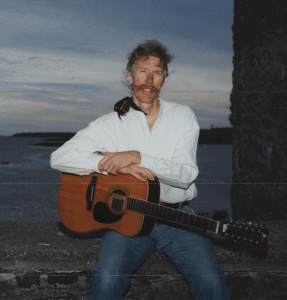
Fred Gosbee with his 12-string guitar. Photo permission and courtesy of Castlebay.
Twelve string guitar, which is made by Nick Appollonio. It has a wider neck and customized to Fred’s “gorilla hands”;
- C penny whistle;
- Low D Bok penny whistle (made by Fred)
- Low F Bok penny whistle (made by Fred);
- Slide whistle (especially used on the song “Waltzing with Bears”);
- Fiddle;
- 17” Viola;
- baroque guitar;
- D Irish flute;
- Bflat Irish flute;
- Violin; and,
- Cello
Castlebay, Fred tells me, “Always seems to have two or three concurrent projects going.”
What is their secret?
Genius, talent, passion for music, a can–do spirit and an infectious love of performing all have contributed to Fred and Julia’s success. I always knew, long ago in the 60s, that my friend was going to be an astonishing talent no matter where his gifts took him. He has seen and experienced terrible adversity, but he used it as fuel to achieve a dream of performing music for others.
They perform now not only at concert series and individual concerts, too, but engage in songwriting residencies in school. Through their music and sense of musicality, they help inspire children’s natural inclination and desire to learn. They engage them in a wonderful process of understanding the material in a way that it can be applied imaginatively by them. Castlebay specializes in teaching “social history through music”.
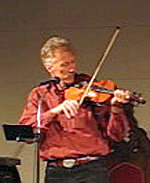
Photo permission & courtesy of Castlebay.
I asked Fred what he enjoys the most about performing.
He responded to my question saying, “The sharing of music and the process of establishing a rapport with an audience. There’s a wonderful energy that’s created when you build with that.”
Only a great craftsman, technician and musician can make such an analogy.
In answering my last question about what insight he has acquired in looking over all of his years of performance, he left me with two statements to consider later on.
The first: “Julia and I have made a practice of saying, ‘Yes’. It’s been scary at times, but we have gone places we never would have with a more cautious approach.”
The second: “Learning to leave more space in playing.”
Fred inspires me for all of the above–stated reasons, but he is also my own age. He’s indomitable.
I look back in time to the days when we were in college together, and I see someone then, whom I always knew was so incredibly talented, who has taken his genius, inventiveness and know–how into the present with such unbounded success. He and Julia are simply phenomenal.
If my old friend can do it, why can’t I? . . .
Related Sites:
Castlebay
Works Cited:
Sloane, Irving. Classic Guitar Construction: Diagrams, Photographs, and Step-by-Step Instructions. New York: E. P. Dutton, 1966. Print.
If you enjoyed reading this post, please share it with others.
Disclosure of Material Connection: I have not received any compensation for writing this post. I have no material connection to the brands, products or services that I have mentioned here. I am disclosing this information in accordance with the Federal Trade Commission’s 16 CFR, Part 255: “Guides Concerning the Use of Endorsements and Testimonials in Advertising.”
© 31 March 2016 by A. Keith Carreiro


